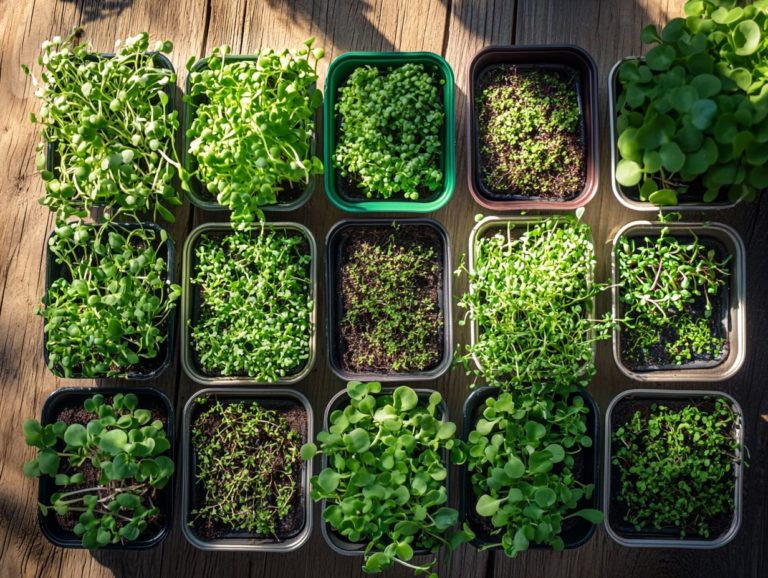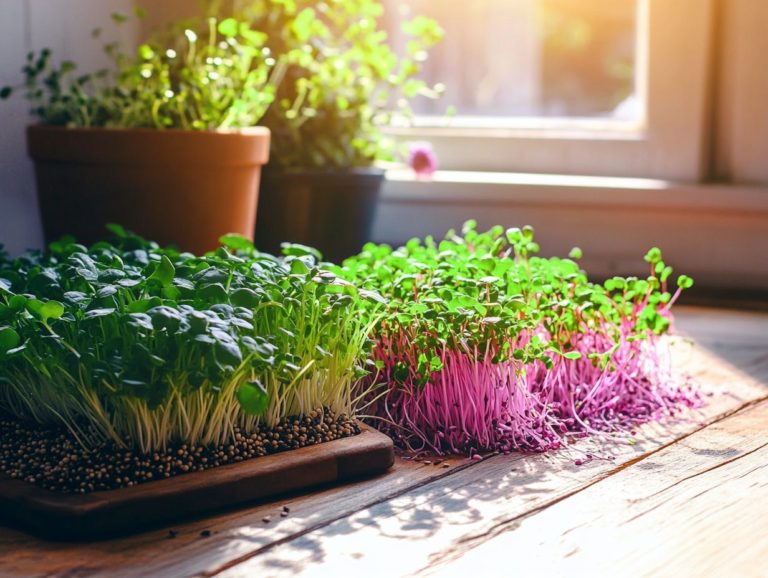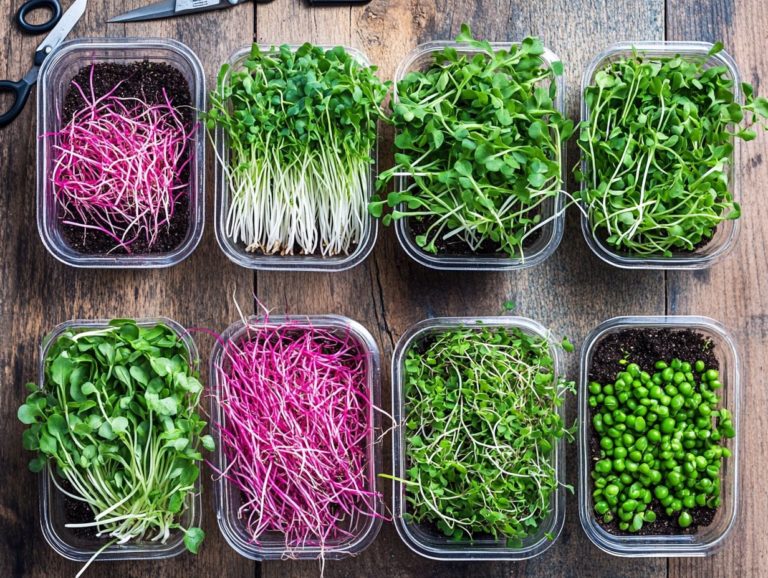7 Microgreens for a Boost in Vitality
Microgreens are those delightful, tiny plants packed with nutrients that bring a wealth of health benefits and culinary creativity to your table. They not only elevate the flavor of your dishes but also provide an impressive range of vitamins and minerals.
This article delves into what microgreens are and their remarkable health advantages, showcasing seven standout varieties, including broccoli, kale, sunflower microgreens, and even fenugreek microgreens. You’ll discover how to seamlessly incorporate these vibrant greens into your meals and even grow them right in your home.
Discover how microgreens can supercharge your vitality and well-being today! They are considered nutrient-dense foods, packed with concentrated nutrients.
Contents
- Key Takeaways:
- 1. Understanding Microgreens
- 2. Health Benefits of Microgreens
- 3. Broccoli Microgreens
- 4. Kale Microgreens
- 5. Sunflower Microgreens
- 6. Radish Microgreens
- 7. Pea Microgreens
- 8. Beet Microgreens
- 9. How to Incorporate Microgreens into Your Diet
- 10. How to Grow Microgreens at Home
- Are There Any Risks or Side Effects of Eating Microgreens?
- Frequently Asked Questions
- What are microgreens and how can they boost my vitality?
- Can I grow my own microgreens at home?
- What are the best microgreens for boosting vitality?
- How should I incorporate microgreens into my diet?
- Are there any potential risks or side effects of consuming microgreens?
- How often should I consume microgreens for a boost in vitality?
Key Takeaways:
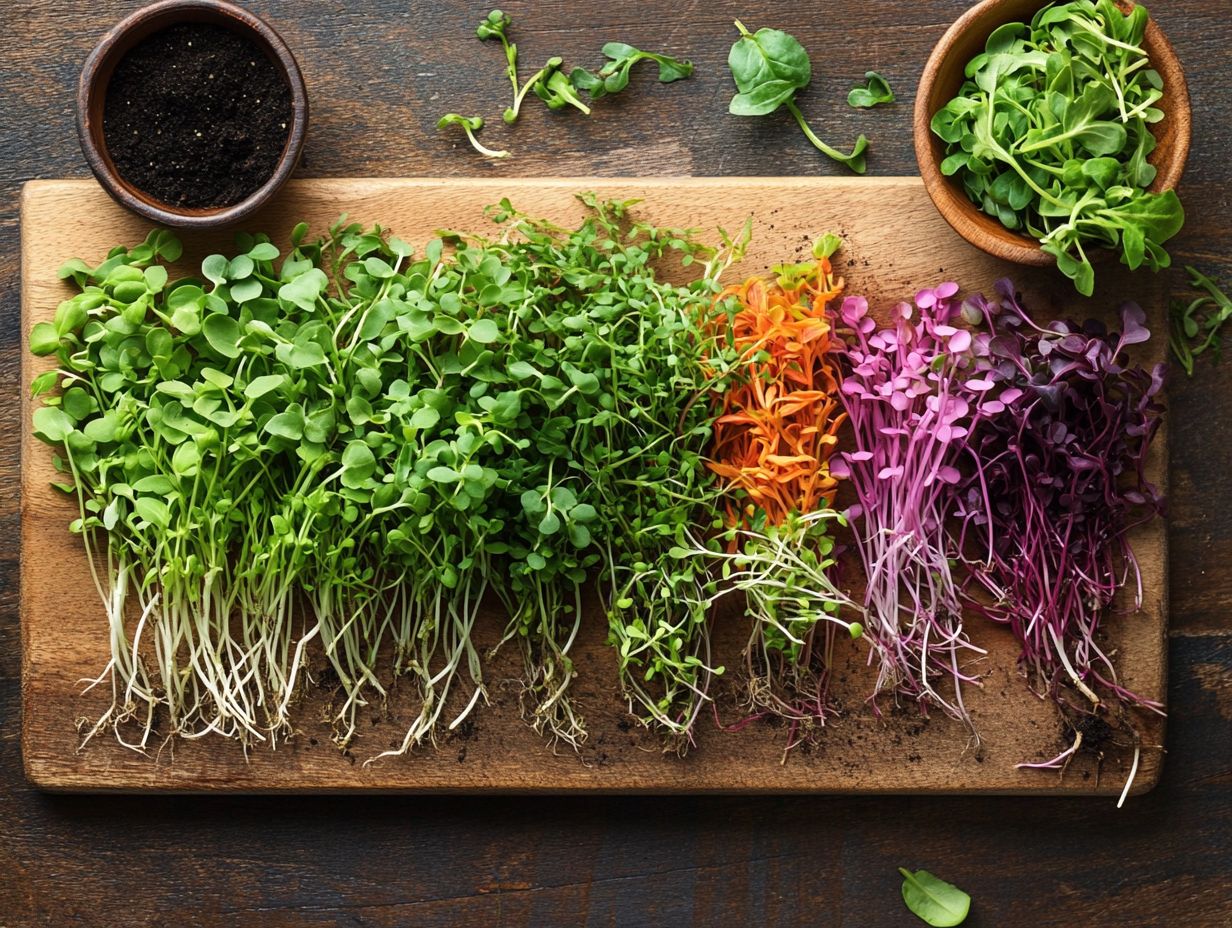
- Include nutrient-rich microgreens like broccoli, kale, and sunflower in your diet for a natural boost in vitality.
- Start adding these powerhouse greens to your meals for an instant health boost! Growing microgreens at home is easy and cost-effective, making it a convenient way to incorporate them into your meals.
- Even though microgreens are small, they are very nutritious and can provide similar benefits to full-grown vegetables.
1. Understanding Microgreens
Microgreens are young vegetables harvested at an early growth stage, bursting with concentrated nutrients that deliver remarkable health benefits, making them essential for healthy eating. These petite greens not only introduce vibrant flavors and colors to your dishes but also serve as an exceptional source of essential vitamins, minerals, and antioxidants.
With their rich nutritional profile, microgreens have captured the attention of health enthusiasts and chefs alike, as they play a significant role in promoting a balanced diet and overall wellness.
What sets them apart from regular vegetables is not just their size but also their flavor intensity and nutritional density often showcasing tastes that range from peppery to sweet. Varieties like arugula, radish, and basil microgreens offer unique flavors that can transform simple meals into gourmet experiences.
Their versatility shines through in various culinary applications, whether as a garnish, an ingredient in salads, or a topping for sandwiches and soups. These micro-sized powerhouses have secured their spot in modern diets, appealing to those who prioritize health, flavor, and sustainability in their food choices.
2. Health Benefits of Microgreens
Microgreens are truly remarkable for their impressive health benefits, providing a powerful nutritional punch that can significantly enhance your overall well-being and vitality. These nutrient-dense foods are loaded with vitamins, minerals, and antioxidants, all of which play a crucial role in boosting immune function, elevating energy levels, and preventing chronic ailments.
Research suggests that adding microgreens to your diet can also assist in managing insulin resistance a condition where the body doesn’t use insulin effectively and enhancing cognitive function, which refers to the ability to think, learn, and remember, making them a stellar addition to a balanced eating plan.
Their concentrated nutrients, often found in varieties like broccoli, kale, and radish, can help combat oxidative stress a major contributor to chronic diseases such as diabetes and heart disease. Scientific studies, including those highlighted by experts at the Cleveland Clinic, indicate that the high levels of vitamins C and E in microgreens can strengthen your immune health, potentially reducing the severity and frequency of illnesses.
The anti-inflammatory properties of microgreens may support brain health, with research suggesting a connection between their consumption and improved memory and focus. This underscores the importance of integrating microgreens into your everyday meals for optimal health outcomes.
3. Broccoli Microgreens
Broccoli microgreens are your secret weapon for a nutrition upgrade, brimming with potent antioxidants and a rich concentration of sulforaphane, a compound that may help fight cancer. These young greens aren t just a feast for the eyes; they pack a flavorful punch and are loaded with iron and essential vitamins, making them a nutrient-rich addition to any diet.
Research suggests that incorporating broccoli microgreens into your meals may help prevent cell damage and lower the risk of chronic diseases. They position themselves as formidable allies in your health journey.
Integrating these microgreens into your meals is easy and delightful. Toss them into salads, blend them into smoothies, or sprinkle them as a garnish on your favorite sandwiches and omelets.
They re rich in vitamins A, C, and E, along with essential minerals like calcium and magnesium. These nutrients support your immune function and bone health.
Studies featured in reputable journals like the Journal of Agricultural and Food Chemistry illustrate how sulforaphane can kickstart detoxification processes in your body and may offer protective effects against cancer.
As a convenient addition to your kitchen, broccoli microgreens elevate the flavor of your dishes and boost your overall nutritional intake. Don t miss out incorporate these microgreens today to enhance your health!
4. Kale Microgreens
Kale microgreens are a nutrient-rich choice, offering the perfect balance of low fat and high vitamins. These petite greens not only delight your palate but also promote mental clarity and overall wellness, brimming with nutrients that support both physical and cognitive health.
Rich in antioxidants, kale microgreens help combat oxidative stress and inflammation, contributing to enhanced energy levels and vitality.
Loaded with vitamins A, C, K and essential minerals like calcium and magnesium, these microgreens are crucial for fortifying your immune system and supporting bone health. Research indicates that adding these vibrant greens to your meals can boost memory and improve cognitive functions, helping you achieve sharper mental clarity. To learn more about enhancing your dishes, check out how to supercharge your meals with microgreens.
Use them in a fresh salad, blend them into a smoothie for an extra nutrient boost, or garnish soups for an explosion of flavor. Their versatility makes them easy to integrate into your culinary repertoire.
For a delightful twist, mix them into scrambled eggs or add them to stir-fries for both flavor and nutrition. Start reaping the myriad benefits today!
5. Sunflower Microgreens
Sunflower microgreens are not just a feast for the eyes; they re also a powerhouse of energy-boosting nutrients and plant-based compounds that enhance your overall health. These young greens are packed with nutrients that will energize your day!
Rich in vitamins A, C, E, and K, along with vital antioxidants, sunflower microgreens support skin health, boost immunity, and offer cellular protection. Their healthy fats, especially omega-6 fatty acids, provide anti-inflammatory benefits and support heart health.
In the kitchen, toss these microgreens into salads for a delightful crunch, blend them into smoothies for an invigorating nutrient boost, or use them as a vibrant garnish on entrees. They offer a rich source of high vitamins.
For the creatively inclined, fold them into omelets or use them as a lively topping on pizzas for delicious meals brimming with health benefits. Add sunflower microgreens to your meals today for a nutritious upgrade!
6. Radish Microgreens
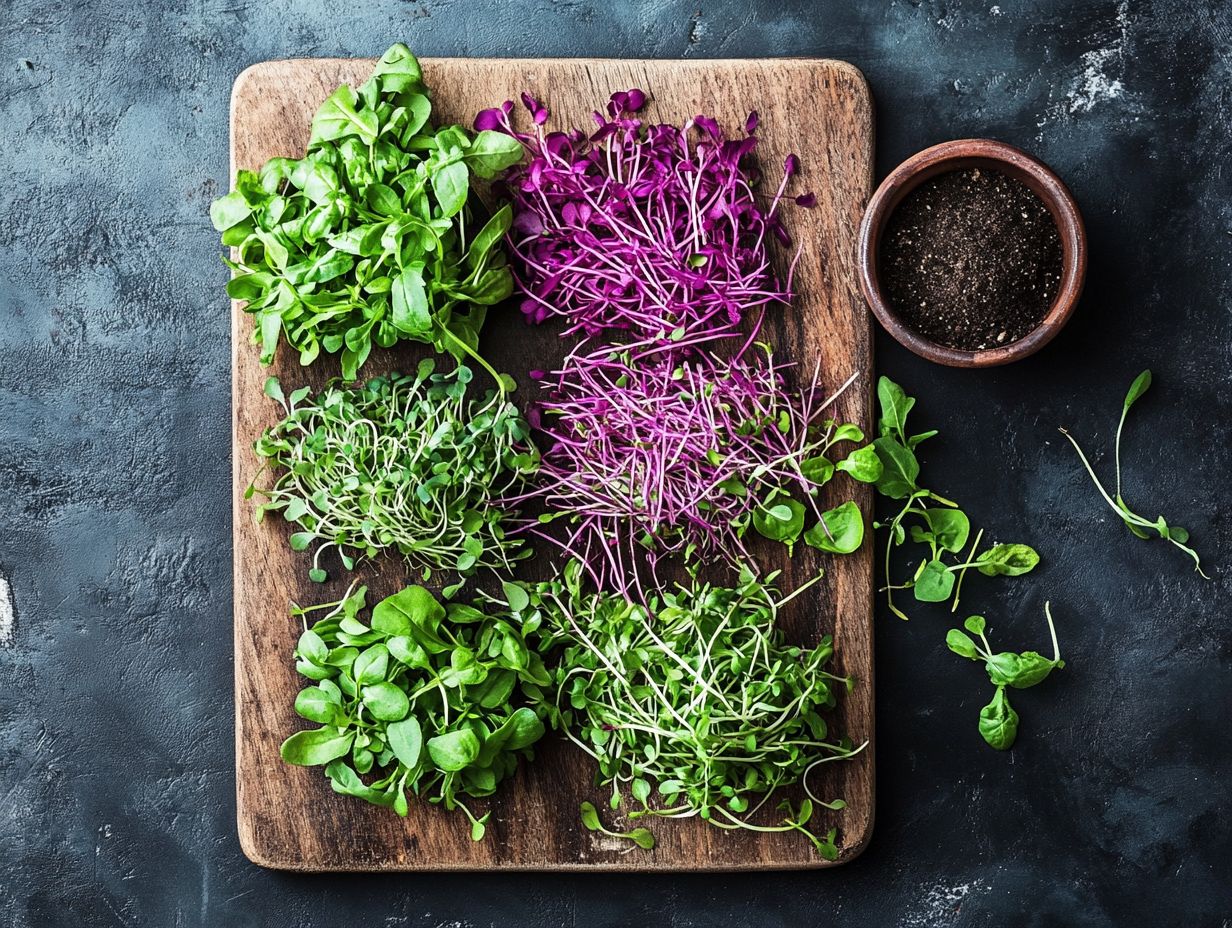
Radish microgreens are truly remarkable. They offer a concentrated burst of nutrients along with a zesty flavor that brings a multitude of health benefits. These colorful greens pack a punch with vitamins, minerals, and antioxidants, including natural compounds found in some vegetables that may help protect against cancer, making them an exceptional addition to a well-rounded diet.
Their unique flavor profile not only elevates your dishes but also enhances your overall health. Don t miss out on the vibrant taste and health benefits of radish microgreens!
Rich in compounds like glucosinolates, these microgreens may play a significant role in reducing the risk of certain cancers while also supporting liver function. You can effortlessly sprinkle these tiny greens on salads or sandwiches for that extra crunch. For even more benefits, explore 7 microgreens for a stronger immune system by blending them into smoothies, or using them as a delightful garnish for soups and seafood.
Recent research shows radish microgreens can promote cognitive health. The antioxidants they contain might help combat oxidative stress in the brain. Start adding these superfoods to your meals today and feel the difference!
7. Pea Microgreens
Ready to discover the amazing benefits of pea microgreens? Let s dive in! Pea microgreens are a delightful and nutrient-rich addition to your meals, celebrated for their impressive vitamin content and their ability to boost energy levels perfect for maintaining a balanced diet.
Not only are these tiny greens packed with vitamins A, C, and K, but they also provide significant amounts of folate and iron. Both contribute to improved metabolism and blood health. For more insights, explore the health benefits of colorful microgreens. Incorporating them into your daily meals is effortless; simply toss a handful into a vibrant salad for that crunchy texture or layer them in a sandwich for a refreshing twist.
These microgreens also blend seamlessly into smoothies, adding a subtle pea-like sweetness that enhances other fruits. Consider using them as a unique pizza topping or a garnish for soups; they bring both a pop of color and essential nutrients to the table. Make them a truly versatile ingredient for anyone committed to a healthy lifestyle.
8. Beet Microgreens
Beet microgreens are not just a feast for the eyes with their vibrant hues; they’re also a powerhouse of iron and antioxidants that promote mental clarity and overall well-being. These nutrient-dense greens have become increasingly popular for their unique flavor and impressive health benefits. They make an exceptional addition to a wide range of dishes.
With their ability to enhance cognitive function and combat oxidative stress, beet microgreens can significantly support your pursuit of a healthier lifestyle.
Loaded with essential vitamins like A, C, and E, they boost immune function and benefit skin health while remaining low in calories. Culinary aficionados rave about their earthy taste, which beautifully complements salads, sandwiches, and smoothies.
In fact, studies suggest that incorporating these microgreens into your daily diet can lead to enhanced neuroprotection. This makes a compelling case for their use not only in home kitchens but also in professional culinary environments. Their striking appearance elevates any dish, adding both nutritional value and a visual delight.
9. How to Incorporate Microgreens into Your Diet
Adding microgreens to your meals is a simple and delicious way to boost nutrition. Enjoy a mix of flavors while benefiting from their concentrated nutrients.
Microgreens bring vibrant colors and health benefits to your plate. They inspire creativity and help you enjoy nutrient-rich foods daily.
Start your day by sprinkling a handful of arugula or mustard microgreens atop your morning omelet for a zesty peppery kick. For a refreshing afternoon smoothie, blend in some pea shoots for a fresh, green boost. Incorporating microgreens for a healthier lifestyle can elevate your meals even further.
At lunch, enhance your sandwiches by layering radish microgreens for that perfect crisp texture and a touch of spiciness. For dinner, elevate your dishes by garnishing soups or pasta with basil or kale microgreens, adding both a vibrant pop of color and enhanced flavor.
Dive into the world of microgreens! They not only diversify your meals but also turn healthy eating into a fun adventure.
10. How to Grow Microgreens at Home
Growing microgreens at home is accessible and incredibly rewarding. You can enjoy fresh, nutrient-dense foods right from your kitchen.
With minimal space and resources, cultivating a variety of microgreens is easy, allowing you to harness their health benefits while enhancing the flavor of your meals.
Choosing the right seeds is key; consider options like radish, basil, and sunflower, which are favored by beginners for their rapid growth and delightful flavors. Use a shallow tray filled with quality potting soil. Spread the seeds evenly and gently press them into the soil.
Proper watering is essential keep the soil moist but avoid over-saturating it. Microgreens typically take about 7 to 21 days to reach that perfect harvestable height. During this time, you’ll enjoy witnessing the vibrant colors come to life.
When the leaves fully unfold, simply cut the greens just above the soil. They make a fantastic addition to salads and sandwiches or serve as garnishes, delivering an impressive boost of vitamins and minerals to your meals.
Are There Any Risks or Side Effects of Eating Microgreens?
While microgreens are packed with health benefits and nutritional advantages, it s vital to be aware of the potential risks or side effects that can arise from consuming them.
Factors like improper handling and contamination can lead to foodborne illnesses, emphasizing the importance of sourcing microgreens from reputable suppliers or cultivating them safely at home.
It’s essential to wash microgreens thoroughly before eating them, even if they come with a pre-washed label. These tiny greens can hide pesticides, pathogens, or soil residues that could compromise your health.
Adhering to proper food safety practices like keeping growing areas clean and using sanitized equipment can significantly reduce these risks. If you’re growing microgreens at home, ensure good air circulation and avoid overwatering to prevent mold growth.
By taking these simple steps, you can enjoy the amazing benefits of microgreens while staying safe from contamination or foodborne illnesses.
What Are the Nutritional Benefits of Microgreens?
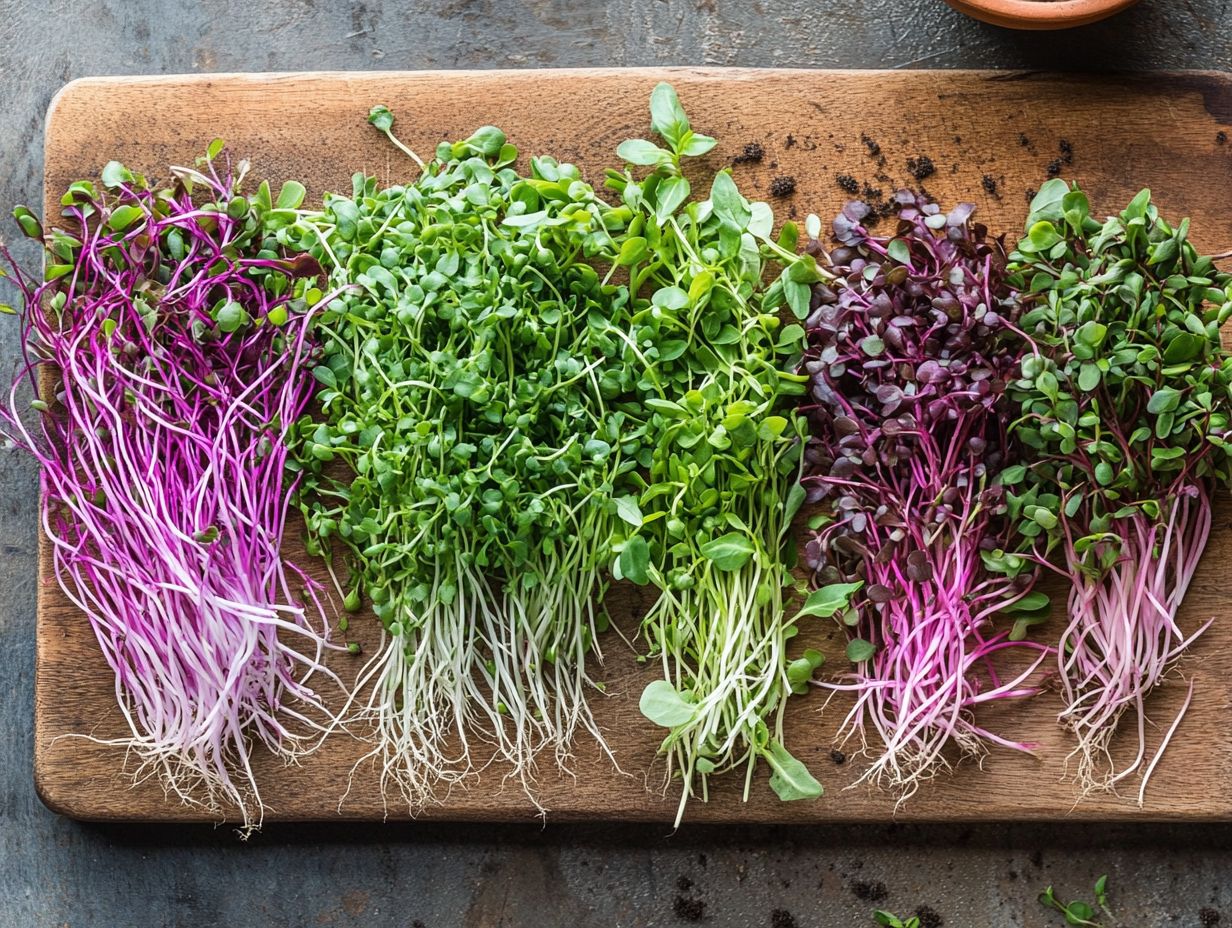
Microgreens are truly remarkable for their exceptional nutritional benefits. These tiny greens offer concentrated nutrients that often surpass those found in their mature counterparts, earning them the title of superfood. Packed with vitamins, minerals, and antioxidants, microgreens can significantly enhance your health, from improving immune function to boosting cognitive performance.
Their impressive nutrient density makes them an essential part of a balanced diet, promoting overall wellness and vitality. Research shows that varieties like broccoli, radish, and sunflower microgreens are rich in vitamins C, E, and K, along with essential minerals such as calcium and magnesium. To further boost your health, consider incorporating microgreen varieties that boost your immune system. These nutrients play crucial roles in supporting bone health, enhancing skin vitality, and fighting oxidative stress.
A study from the Journal of Agricultural and Food Chemistry reveals that microgreens can contain up to 40 times more nutrients than their fully grown counterparts. Try incorporating a variety of microgreens, including the top 10 microgreens for nutritional boost, into your meals for a delicious and nutritious twist!
How Do Microgreens Compare to Full-Grown Vegetables?
When you compare microgreens to their fully grown counterparts, it quickly becomes clear that these petite greens often offer superior nutritional benefits. They are brimming with concentrated nutrients, providing higher levels of vitamins, minerals, and antioxidants than their mature vegetable relatives.
This remarkable nutrient density supports a balanced diet and emphasizes the importance of incorporating microgreens into your daily meals for optimal health outcomes. For instance, studies reveal that broccoli microgreens can contain up to 40 times more vitamin E and C compared to mature broccoli, highlighting their role as a powerhouse of nutrients.
Similarly, radish microgreens bring a zesty punch along with a remarkable concentration of compounds found in certain vegetables that may help prevent cancer, which are significantly less prevalent in their mature counterparts. For those interested in exploring more, check out the top microgreen varieties for health enthusiasts.
These attributes showcase the substantial differences in nutritional profiles and illuminate why adding microgreens to your salads, smoothies, or sandwiches can deliver an impressive health boost. By cultivating microgreen varieties for your health, you can play a pivotal role in enhancing your overall health and well-being.
What Are Some Delicious Ways to Use Microgreens in Meals?
Get creative! Microgreens fit perfectly into your meals in countless delicious ways, enhancing flavor, nutrition, and visual appeal while promoting a balanced diet. Whether it s in salads, sandwiches, soups, or smoothies, these tiny greens add a burst of flavor and essential nutrients wherever they make an appearance.
Consider the peppery kick of arugula microgreens; they can elevate a classic caprese salad, harmonizing beautifully with ripe tomatoes and fresh mozzarella. On the other hand, the subtle sweetness of sunflower microgreens provides a delightful contrast when nestled into a savory grilled cheese.
Incorporating radish microgreens into tacos introduces a zesty flair, while delicate pea shoots can be tossed into pasta dishes for an unexpected freshness. Imagine a colorful plate bursting with freshness! By thoughtfully pairing these vibrant greens with complementary ingredients, you can transform ordinary meals into gourmet experiences, bursting with color and flavor.
Can Microgreens Be Used for Medicinal Purposes?
Microgreens have captured attention for their potential medicinal benefits. They offer health perks that go well beyond basic nutrition. Their rich content of plant-based substances positions them as nutrient-dense foods believed to support various health conditions, including inflammation, antioxidant deficiencies, and cognitive decline.
By incorporating specific microgreens into your diet, you can enhance your overall well-being through natural, dietary solutions.
Research has spotlighted microgreens like broccoli and kale. These are packed with sulforaphane a compound that may help reduce inflammation and support detoxification. These little greens can seamlessly fit into salads, smoothies, or sandwiches, adding versatility to any health-focused meal plan.
Consider red cabbage microgreens, which are full of antioxidants that may lower the risk of chronic diseases. Or try beet greens, known for their heart health benefits. As more studies unveil the extensive medicinal advantages of these tiny powerhouses, it’s becoming increasingly clear that adding them to your daily meals is a tasty way to boost your health. For more information, explore microgreen varieties and their health benefits.
What Are Some Common Myths About Microgreens?
Despite the rising popularity of microgreens, several myths continue to mislead people about their nutritional benefits and cooking uses. For example, many think that microgreens lack essential nutrients compared to fully grown vegetables. However, they often have a higher concentration of vitamins and minerals.
By debunking these misconceptions, you can gain a clearer understanding of microgreens and their important role in promoting a healthy, balanced diet.
You may also believe that microgreens are just a garnish rather than a legitimate food source. However, these small, vibrant plants can truly elevate the flavors and textures of a wide variety of dishes, from salads to sandwiches.
If you think that growing microgreens is only for those with a green thumb, think again. It can be done easily indoors or outdoors, requiring minimal space and effort. By understanding the truth about these nutrient-packed greens, you can inspire yourself to incorporate them into your meals, benefiting not only your health but also enriching your culinary experiences.
Frequently Asked Questions
What are microgreens and how can they boost my vitality?
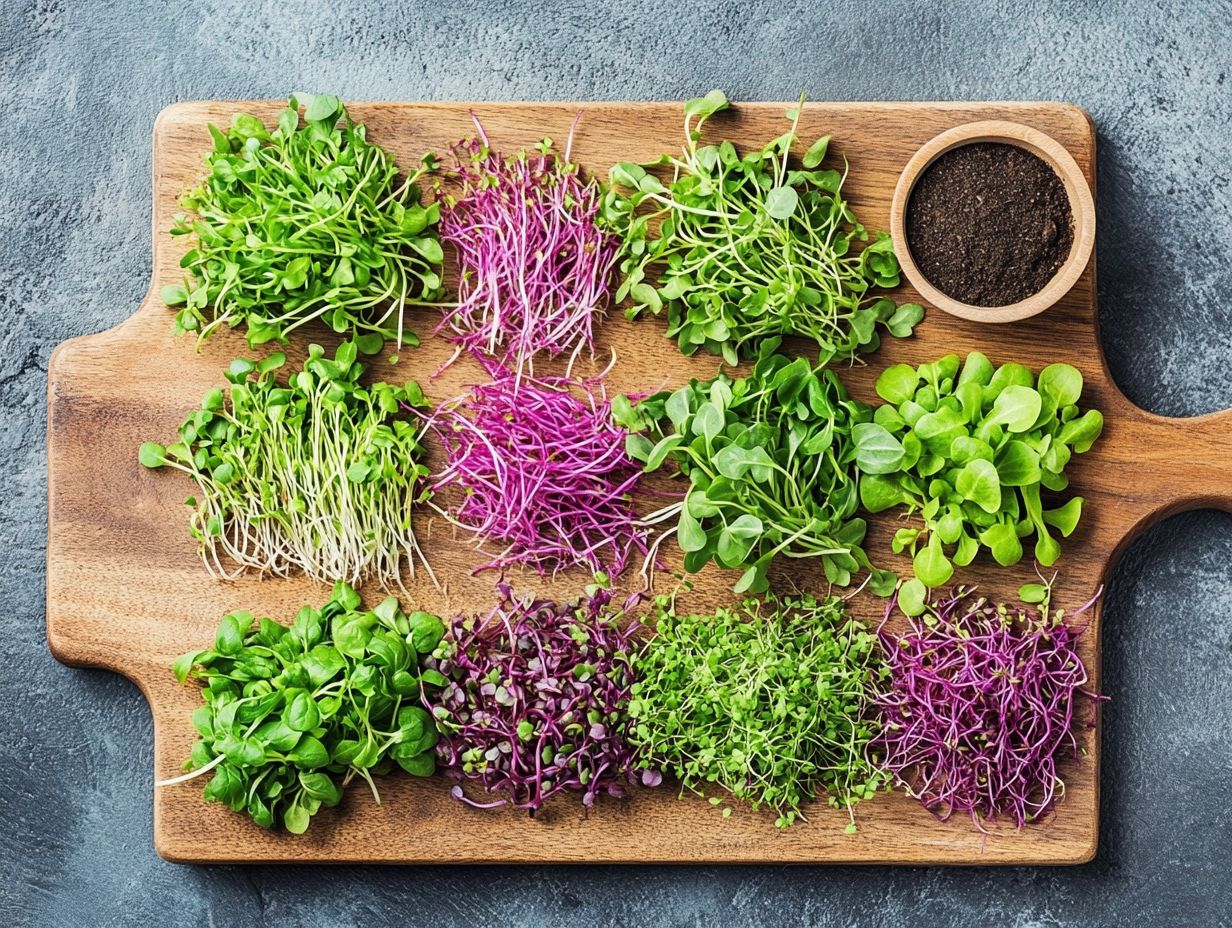
Microgreens are young vegetable greens that are harvested after the first leaves have fully developed. They are packed with nutrients and often have a higher concentration of vitamins and minerals than their full-grown counterparts. This makes them a great addition to any diet for a boost in vitality.
Can I grow my own microgreens at home?
Yes, microgreens are easy to grow at home and require minimal space and maintenance. You can use a shallow container, such as a tray or pot, along with some potting soil to grow a variety of microgreens right in your own kitchen or backyard.
What are the best microgreens for boosting vitality?
Some of the most popular microgreens for boosting vitality include broccoli, kale, watercress, and sunflower microgreens. These varieties are rich in antioxidants, vitamins, and minerals that can help improve overall health and well-being.
How should I incorporate microgreens into my diet?
Microgreens can be added to salads, sandwiches, smoothies, and other dishes to provide a fresh burst of flavor and nutrition. You can also use them as a garnish or topping for your favorite meals for an extra boost of vitality.
Are there any potential risks or side effects of consuming microgreens?
While microgreens are generally safe to consume, it’s important to wash them thoroughly before eating to avoid any potential bacteria or contamination. Additionally, if you have any allergies or sensitivities to certain plants, it s best to consult with a healthcare professional before incorporating microgreens into your diet.
How often should I consume microgreens for a boost in vitality?
There’s no set amount of microgreens you need to eat, but regularly enjoying different varieties is key to boosting your vitality.
Try adding them to salads, smoothies, or sandwiches to maximize their benefits!

